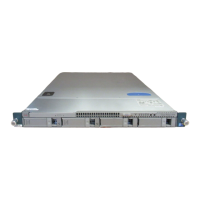LACP System Priority
Each system that runs LACP has an LACP system priority value. It has a default value of 32768 and is not
configurable. LACP uses the system priority with the MAC address to form the system ID and also uses the
system priority during negotiation with other devices. A higher system priority value means a lower priority.
The LACP system ID is the combination of the LACP system priority value and the MAC address.Note
LACP Port Priority
Each port that is configured to use LACP has an LACP port priority. It has a default value of 32768 and is
not configurable. LACP uses the port priority with the port number to form the port identifier.
LACP uses the port priority to decide which ports should be put in standby mode when there is a limitation
that prevents all compatible ports from aggregating and which ports should be put into active mode. A higher
port priority value means a lower priority for LACP. You can configure the port priority so that specified
ports have a lower priority for LACP and are most likely to be chosen as active links, rather than as hot-standby
links.
LACP Administrative Key
LACP automatically configures an administrative key value that isequal to the channel entry index (1 through
8) for each port on the VEM configured to use LACP. The administrative key defines the ability of a port to
aggregate with other ports. A port’s ability to aggregate with other ports is determined by these factors:
•
Port physical characteristics, such as the data rate and the duplex capability
•
Configuration restrictions that you establish
LACP Marker Responders
You can dynamically redistribute the data traffic by using port channels. This redistribution may result from
a removed or added link or a change in the load-balancing scheme. Traffic redistribution that occurs in the
middle of a traffic flow can cause misordered frames.
LACP uses the Marker Protocol to ensure that frames are not duplicated or reordered due to this redistribution.
The Marker Protocol detects when all the frames of a given traffic flow are successfully received at the remote
end. LACP sends Marker PDUs on each of the port-channel links. The remote system responds to the Marker
PDU once it receives all the frames received on this link prior to the Marker PDU. The remote system then
sends a Marker Responder. Once the Marker Responders are received by the local system on all member links
of the port channel, the local system can redistribute the frames in the traffic flow with no chance of misordering.
The software supports only Marker Responders.
LACP-Enabled and Static Port Channels Differences
The following table summarizes the major differences between port channels with LACP enabled and static
port channels.
Cisco Nexus 1000V for VMware vSphere Interface Configuration Guide, Release 5.x
52
Configuring Port Channels
LACP Marker Responders

